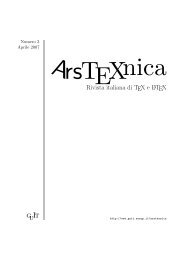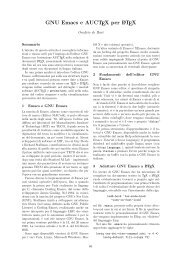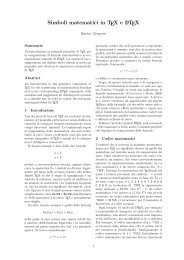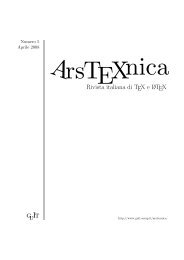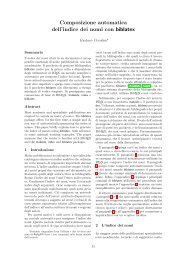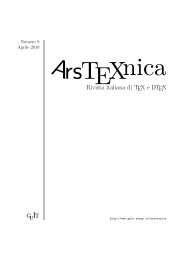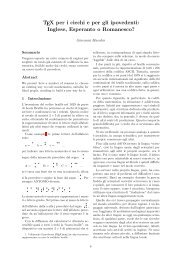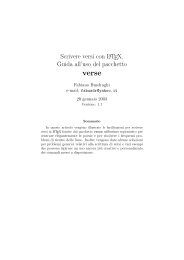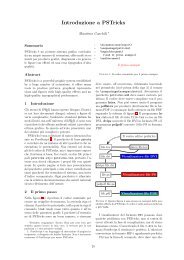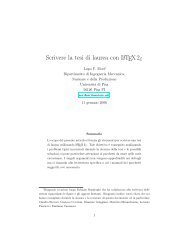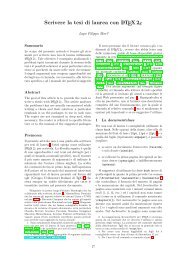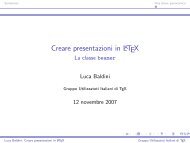ArsTeXnica, Numero 4, Ottobre 2007 - GuIT - Scuola Superiore Sant ...
ArsTeXnica, Numero 4, Ottobre 2007 - GuIT - Scuola Superiore Sant ...
ArsTeXnica, Numero 4, Ottobre 2007 - GuIT - Scuola Superiore Sant ...
You also want an ePaper? Increase the reach of your titles
YUMPU automatically turns print PDFs into web optimized ePapers that Google loves.
ArsT EXnica Nº 4, <strong>Ottobre</strong> <strong>2007</strong> Guidelines for Bibliographical Citations in LAT EX<br />
\begin{bibdiv}<br />
\begin{biblist}<br />
\bib{herbert-anderson2000}{book}{<br />
author={Herbert, Brian},<br />
author={Anderson, Kevin~J.},<br />
title={House {Atreides}},<br />
series={Prelude to Dune},<br />
publisher={Bantam},<br />
date={2000},<br />
number={1},<br />
}<br />
...<br />
\end{biblist}<br />
\end{bibdiv}<br />
Figure 6: References produced by the amxport bibliography<br />
style.<br />
particular parts of a reference within a text’s body.<br />
It aims to allow the specification of formatting<br />
bibliographical references using L ATEX-like syntax.<br />
That is done by means of the functionalities of the<br />
amsrefs package.<br />
A more modern implementation of this modus<br />
operandi is the bib module of ConTEXt (Hoekwater,<br />
2006), the result of processing our bibliography<br />
sample being given in Figure 7. In<br />
ConTEXt (see Hagen, 2001, § 2.2), commands<br />
like ‘\start...’ and ‘\stop...’ are analogous to<br />
environment delimiters in L ATEX (‘\begin{...}’<br />
and ‘\end{...}’). The structured information<br />
put between the commands \startpublication<br />
and \stoppublication may be customised as described<br />
in (Hoekwater, 2006, § 2.2) by means of the<br />
\setuppublicationlist command. In particular,<br />
this command allows authors’ names to be typeset<br />
in extenso or abbreviated, but such customisation<br />
exists for the ‘References’ section, not for citations<br />
of authors’ names inside a text. The bib module 11<br />
also provides an advanced command for citations<br />
(see Hoekwater, 2006, § 3), e.g.:<br />
\cite[author][robeson1974b]<br />
Let us remark that only some options are available:<br />
author, authoryear, year, . . . but this command<br />
cannot put only a title. The layout of the texts<br />
produced by this command may be customised by<br />
means of the \setupcite command. In Figure 8,<br />
you can see how to get a publication’s year with<br />
delimiters: by associating characters to the keywords<br />
left and right within an accurate \setupcite<br />
command. To get the same information without delimiters<br />
later in the text, use this command again<br />
with these two keywords associated to blank values.<br />
11. Roughly speaking, a ConTEXt module is analogous<br />
to a LATEX 2ε package.<br />
108<br />
\startpublication[k=herbert-anderson2000,<br />
t=book,<br />
a={{Herbert},{Anderson}},y=2000,<br />
n=1,s=HA00]<br />
\author[]{Brian}[B.]{}{Herbert}<br />
\author[]{Kevin~J.}[K.~J.]{}{Anderson}<br />
\pubyear{2000}<br />
\title{House {Atreides}}<br />
\series{Prelude to Dune}<br />
\volume{1}<br />
\pubname{Bantam}<br />
\month{2}<br />
\stoppublication<br />
...<br />
\startpublication[k=robeson1974c,t=book,<br />
a={{Robeson}},y=1974b,<br />
n=3,s=Rob74b]<br />
\author[]{Kenneth}[K.]{}{Robeson}<br />
\pubyear{1974\maybeyear{b}}<br />
\title{The Devil Genghis}<br />
\series{Doc Savage Series}<br />
\volume{79}<br />
\pubname{Bantam}<br />
\month{11}<br />
\stoppublication<br />
Figure 7: References used by the bib module of ConTEXt.<br />
Roughly speaking, such an exercise may be viewed<br />
as worthwhile. . . or tedious. In fact, we personally<br />
consider that the approach of this module is<br />
promising, but it could be improved. Last, it is<br />
tightly related to ConTEXt, which does not use<br />
the same commands than L ATEX.<br />
Another point is related to multilinguism: if a<br />
citation command does not put keys, but text fragments,<br />
they should be hyphenated correctly if need<br />
be. By ‘correctly’, we mean ‘using the right patterns’,<br />
depending on languages. This is planned<br />
by the functions of the jurabib package, although<br />
all the information concerning a reference is supposed<br />
to be expressed in the same language. For<br />
example, an Italian author may write a text in<br />
English, in which case the title would be properly<br />
hyphenated, but not the author’s name. As<br />
another example related to multilinguism, the connection<br />
between successive co-authors’ names is<br />
also language-dependent: ‘and’ in English, ‘e’ in<br />
Italian, . . . The jurabib package and the bib module<br />
can deal with such language-dependent features,<br />
the natbib package could be improved this way.<br />
5 Conclusion<br />
We personally used the number-only scheme for<br />
a long time. Then we had to rewrite several of<br />
our texts using the author-date scheme. We also<br />
helped some people to prepare written documents




